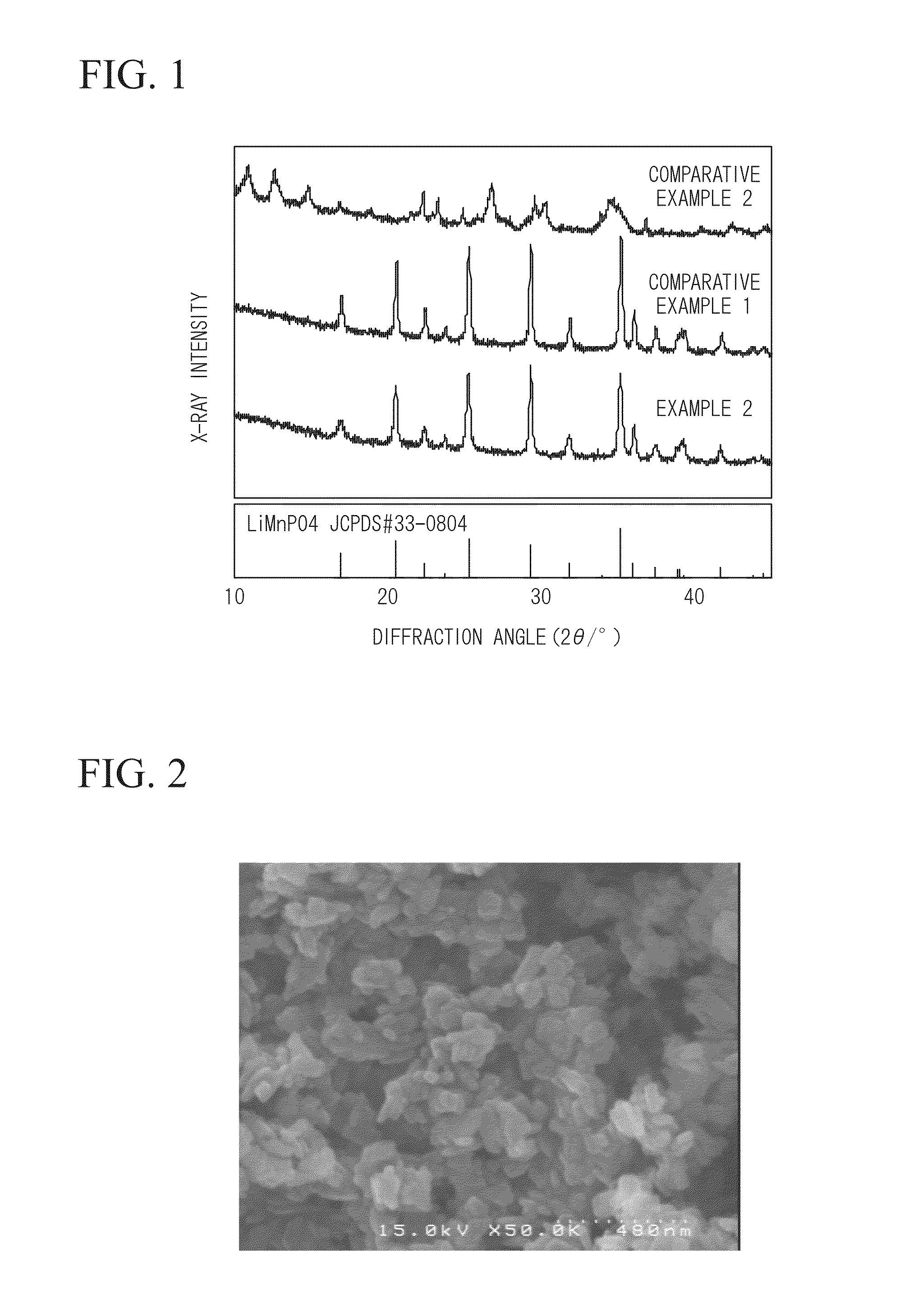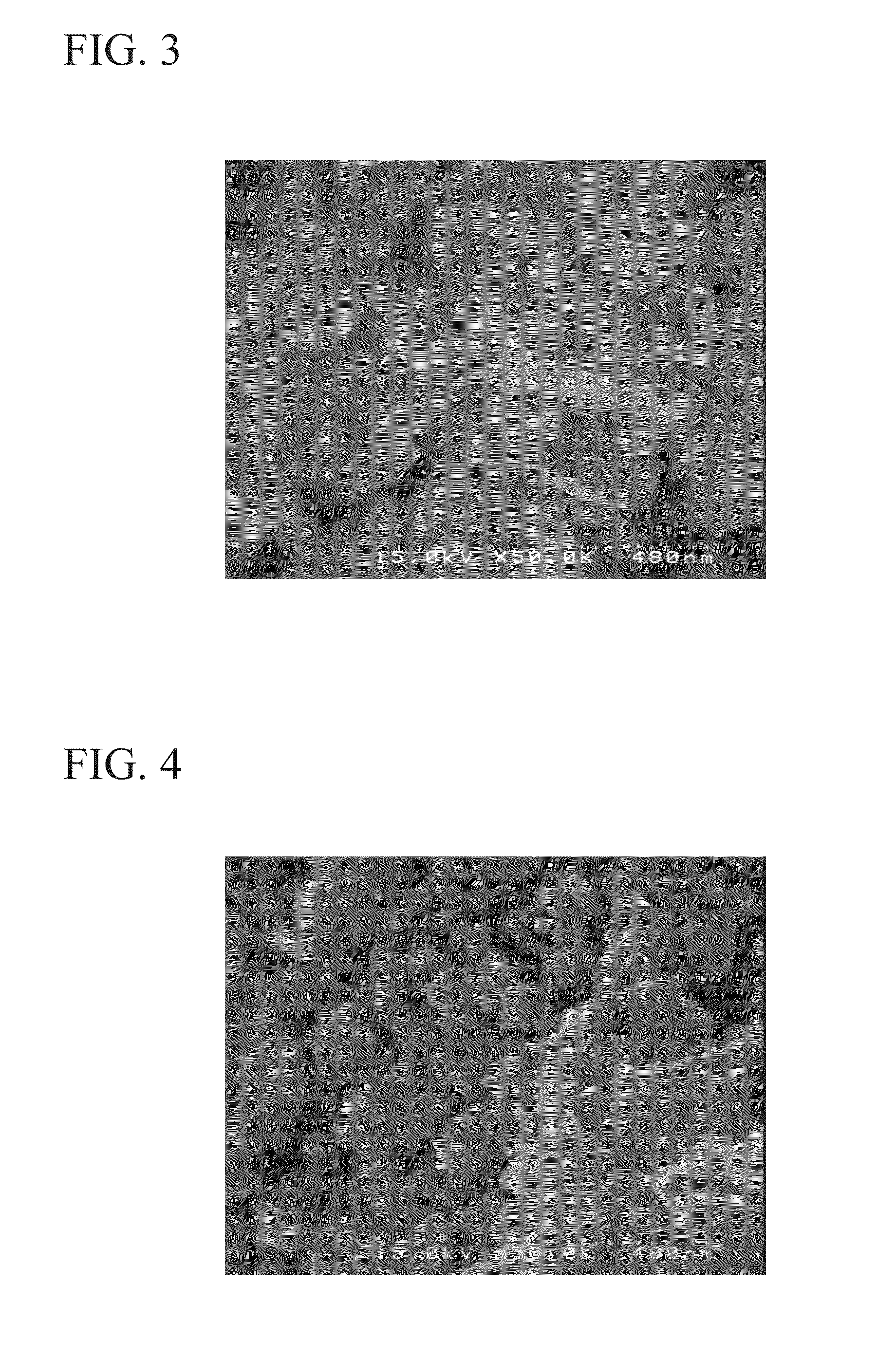Positive electrode active material for lithium ion battery, method of producing the same, electrode for lithium ion battery, and lithium ion battery
a technology of active materials and lithium ion batteries, which is applied in the direction of phosphorus oxyacids, cell components, electrochemical generators, etc., can solve the problems of disadvantages of high-speed charge and discharge of phosphate-based electrode active materials, and achieve excellent stability and safety, high energy density, and high voltage
- Summary
- Abstract
- Description
- Claims
- Application Information
AI Technical Summary
Benefits of technology
Problems solved by technology
Method used
Image
Examples
example 1
[0060]Synthesis of LiMnPO4 was performed as described below.
[0061]Li3PO4 as the Li source and the P source, and aqueous MnSO4 solution as the Mn source were used, and these were mixed in a molar ratio of Li:Mn:P=3:1:1 to prepare 200 ml of raw material slurry.
[0062]Next, the raw material slurry was put into a pressure resistant vessel, and the hydrothermal synthesis was performed at 100° C. for 1 hour. At this time, a pressure inside the pressure resistant vessel was 0.1 MPa.
[0063]After the reaction, the resultant product was cooled to room temperature, whereby a precipitate of a cake-shaped reaction product was obtained. The precipitate was sufficiently washed with distilled water a total of five times, and a moisture content of 30% was maintained so as not to be dried, whereby a cake-shaped material of Example 1 was obtained.
[0064]Next, a little amount of sample was collected from the precipitate, and this sample was vacuum-dried at 70° C. for 2 hours, whereby a powder of Example 1...
example 2
[0069]A cake-shape material and a powder of Example 2 were obtained in the same manner as Example 1 except that the hydrothermal synthesis conditions of the raw material slurry were set to 130° C. and 1 hour.
[0070]An average particle size of the powder was measured using a laser diffraction-type particle size distribution measuring apparatus SALD-2100J (manufactured by Shimadzu Corporation), and the measured average particle size was 39 nm.
[0071]The powder was identified using an X-ray diffraction apparatus, and it was confirmed that single-phase LiMnPO4 was generated. In addition, values of lattice constants were calculated from an X-ray diffraction pattern of the powder, and it could be seen that a=10.429 Å, b=6.085 Å, and c=4.735 Å.
[0072]In addition, the shape of the LiMnPO4 particles which was observed from a scanning electron microscope (SEM) image of the powder was a characteristic plate crystal.
[0073]Furthermore, it could be seen that among peaks of X-ray intensity seen from ...
example 3
[0075]A cake-shape material and a powder of Example 3 were obtained in the same manner as Example 1 except that the hydrothermal synthesis conditions of the raw material slurry were set to 150° C. and 1 hour.
[0076]An average particle size of the powder, was measured using a laser diffraction-type particle size distribution measuring apparatus SALD-2100J (manufactured by Shimadzu Corporation), and the measured average particle size was 78 nm.
[0077]The powder was identified using an X-ray diffraction apparatus, and it was confirmed that single-phase LiMnPO4 was generated. In addition, values of lattice constants were calculated from an X-ray diffraction pattern of the powder, and it could be seen that a=10.424 Å, b=6.088 Å, and c=4.739 Å.
[0078]In addition, the shape of the LiMnPO4 particles which was observed from a scanning electron microscope (SEM) image of the powder was a characteristic plate crystal.
[0079]Furthermore, it could be seen that among peaks of X-ray intensity seen from...
PUM
| Property | Measurement | Unit |
|---|---|---|
| particle size | aaaaa | aaaaa |
| temperature | aaaaa | aaaaa |
| temperature | aaaaa | aaaaa |
Abstract
Description
Claims
Application Information
 Login to View More
Login to View More - R&D
- Intellectual Property
- Life Sciences
- Materials
- Tech Scout
- Unparalleled Data Quality
- Higher Quality Content
- 60% Fewer Hallucinations
Browse by: Latest US Patents, China's latest patents, Technical Efficacy Thesaurus, Application Domain, Technology Topic, Popular Technical Reports.
© 2025 PatSnap. All rights reserved.Legal|Privacy policy|Modern Slavery Act Transparency Statement|Sitemap|About US| Contact US: help@patsnap.com



